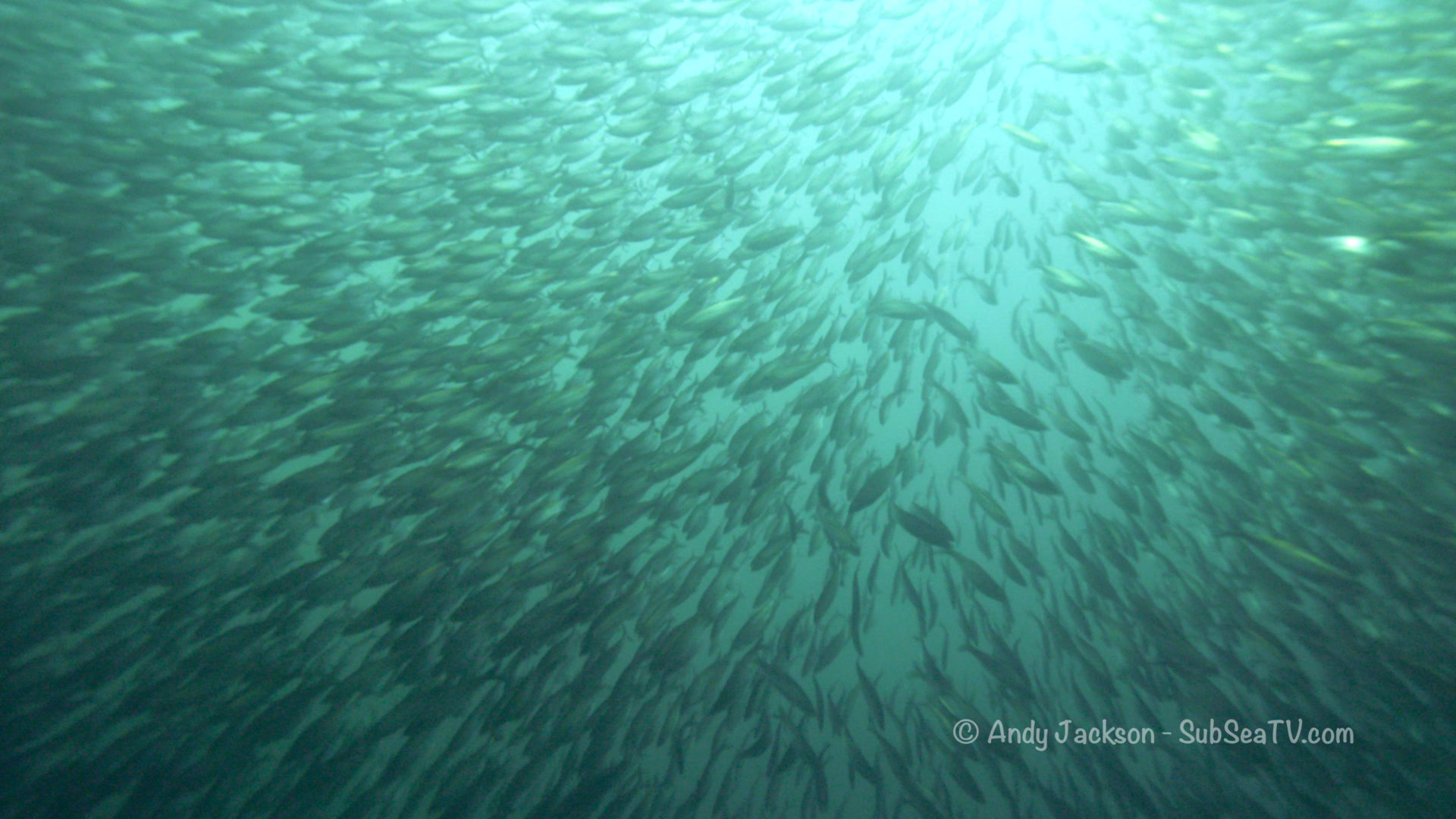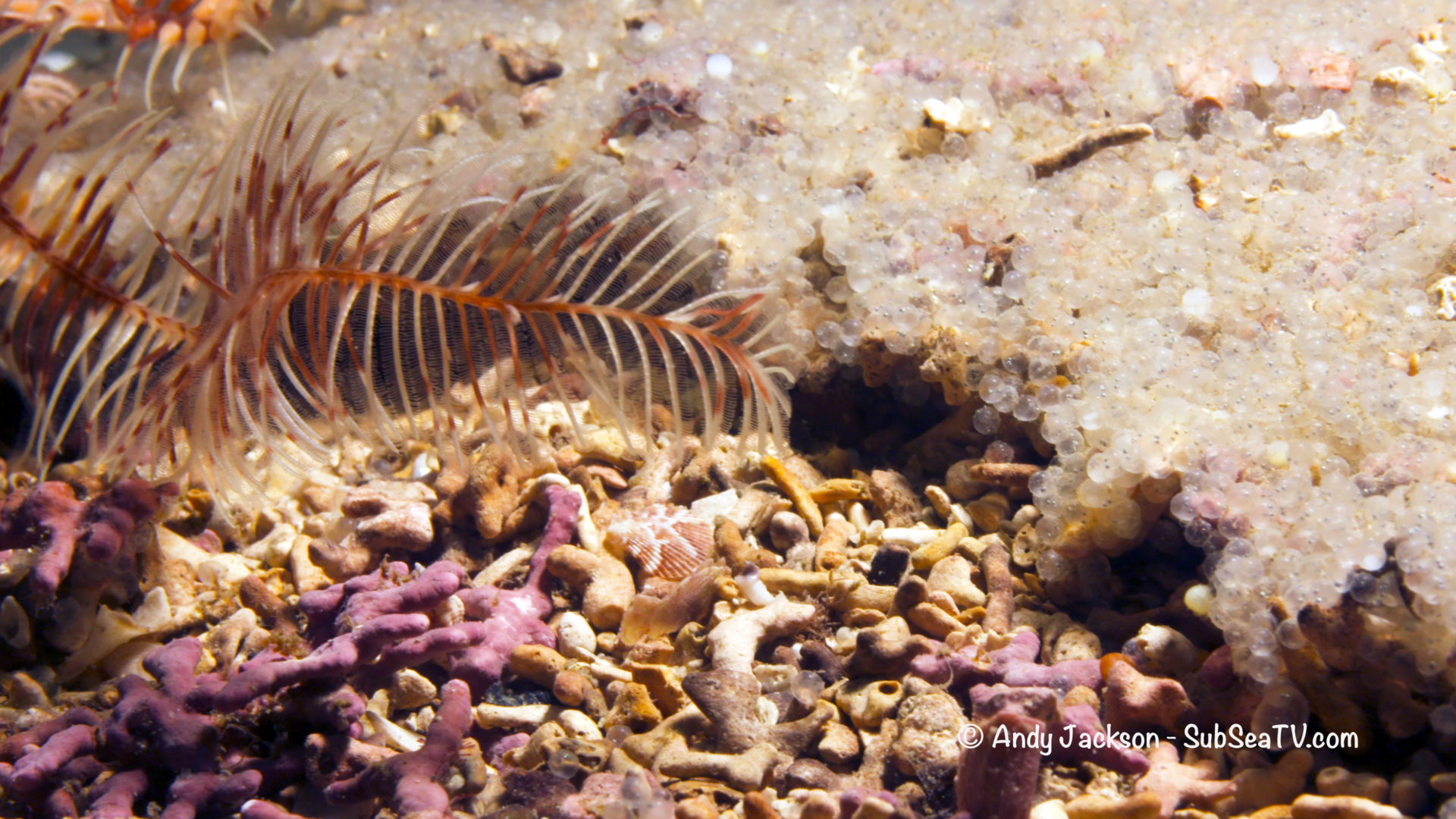Silver Darlings

Blue Planet UK featured my latest filming adventure – wild herring spawn – on Friday 29th March. You can watch the 6-min film on iPlayer (starting at 28mins 17secs) or a shortened trailer here.
The adventure began last year, when Keltic Seafare’s scallop divers found maerl seabed off Gairloch covered in a massive mat of tiny herring eggs. Even the scallops were laden with eggs. Alasdair Hughson of Keltic Seafare sent me the photos that triggered this project.
Traditionally west coast herring spawned in Spring off Gairloch, but they were last seen in the 1970s when the herring fishery collapsed. Some of the older local fishermen could remember fishing for them, but for the most part knowledge had been lost in the mists of time. We were starting with very little information and lots of nagging questions. Do they spawn during the day or at night? Do they only spawn in calm weather as claimed by some fishermen? Which predators would turn up? What tell-tale events help you find them? Do they congregate in the loch before moving to the spawning ground? So many questions, lots of hearsay, but no way to know the facts.
In early March I drove 10 hours north to Gairloch, to join devoted fish biologist Peter Cunningham of Wester Ross Fisheries Trust. Peter has been studying herring movements for ten years and with his advice and expertise to guide us, we would try and film the arrival of the herring. Bill Whyte generously offered his boat and skippering skills. We had good weather for the first few dives, but we were early and couldn’t find a single herring or any sign of seabird feeding.
I realised this was not going to be a quick project and I would have to hang around for the fish and weather to align. It felt like a 50:50 chance of getting the story. Accommodation pressure and cost was relieved by the generosity of David and Patricia Sturrock, who allowed me and ever-helpful diving photographer George Brown to stay in their converted croft, Cairns Cottage.
A weather system of rolling storms set in, making progress difficult. Bill had commitments elsewhere, so we were without a boat until Peter spoke to Noel Hawkins of the Scottish Wildlife Trust, who introduced John MacKenzie of Wester Ross Adventures, a new snorkelling business run from a lovely 26-foot Sea Osprey boat, K2.
On day 7 the weather came good for half a day. John, Peter, and Noel dropped me into a huge shoal of herring on two consecutive dives. On the echo sounder, the shoal filled the water between the seabed at 24m up to 10m below the boat. The fish were moving around pre-spawning, avoiding the seals and gannets. It was an amazing sight to be surrounded by so many fish, an enormous shoal of herring so dense that it blocked out the sun. A total eclipse made of herring!
We dived again that night, hoping for spawning, but the fish were still moving around and swam away so quickly I didn’t get a chance to film them.
It wasn’t until day 12 that another weather window briefly opened. Just a morning of light winds between two storms, but sea conditions settled rapidly and allowed us to get out at 6:30am. The ever-vigilant Peter spotted gannet and seal activity off Red Point and John’s echo sounder showed that the fish had spread out on the bottom and were within a metre of the seabed in a depth of 18m.
I dropped down with my camera into milky blue water that changed into a thick soup of sandy-coloured mirk near the seabed. It was almost dark as I swam along with my video light cutting through the fog. At regular intervals I disturbed spawning herring, their silver bodies scattering before me. The mirk was herring milt, and the seabed was covered with sticky eggs, like a thick mat left by a recent hailstorm, smothering the maerl.
I could hear explosions above me and realised it was the noise of gannets breaking the water surface at high speed. On my way back to the surface I was joined by an inquisitive gannet who swam up to me and stared straight into the camera.
I would have loved to spend more time with the herring but the next storm was gathering and we had to find shelter. That afternoon, I followed the progress of spawning from the cliff top. Diving gannets showed the position of the shoal. We didn’t know if the fish would spawn in rough weather, but they did. The patch of water above the spawning fish turned turquoise where the light was reflected back to the surface by the milty water.
A dreadful forecast sent me home for a week to return for the next weather window. Again, it only lasted for half a day and it seemed like madness driving for 20 hours for such a fleeting moment, but I managed two dives on the egg mat where I filmed in both macro and wide to capture the whole story. My reward was thousands of tiny herring eyes looking back at me as I filmed. Another amazing spectacle of nature, and the project was complete!

Our shared hope now is that the publicity from this project will lead to official recognition of this herring spawning ground and ensure that it is fully protected all year around. We believe it is the maerl habitat that west coast herring prefer for their eggs. Maerl is so delicate in its structure, and so slow growing, that bottom trawlers must be kept away from this habitat at all costs, to ensure the continued recovery of herring.
Herring are such an important part of the marine food chain. They are predated by almost every other marine species, at different stages of their life cycle: sandeels, the cod family, seals, seabirds, humans, cetaceans. If we learn from the over-fishing mistakes of the past, a healthy and robust population of herring could become the keystone for wildlife recovery off the west coast of Scotland.
______________________________________________________________________________
This project would have been impossible without the support of Gairloch’s local heroes. Heartfelt thanks to you all:
The indomitable Peter Cunningham, a devoted expert and wise guide. His enthusiasm and depth of knowledge is incredible. He’s been running a herring project for 10 years and none of this would have possible without Peter. He rallied local people and resources, filmed a lot of the boat shots, and so is now a Blue Planet UK cameraman on top of everything else he does (scientist, naturalist, artist, TV and radio star, McGandalf…)!
Our wonderful skippers John MacKenzie (weeks 2 and 3) Wester Ross Sea Adventures and Bill Whyte (week 1) generously offered their boats and skippering skills to match infrequent, ever-moving weather windows. Their enthusiasm and boating skills got us exactly where we needed to be.
The Wester Ross Fisheries Trust got fully behind the project, freed Peter to focus on the herring spawn, and contributed towards project costs.
David and Patricia Sturrock generously provided Cairns Cottage, their lovely self-catering converted croft in Port Henderson, for three weeks for a peppercorn rent. This enabled us to stick out the rough weather and film magical moments sandwiched between storms. Patricia’s expertise as a marine biologist also helped us access scientific papers and check our facts.
Photographer and fellow diver George Brown of Inverness Sub Aqua Club brought his wonderful company, impressive marine knowledge, and compressor for air fills.
Director of Keltic Seafare Alasdair Hughson sent me the photos of herring eggs on the seabed, with positional information, that kick-started the filming project. He also provided additional air fills for diving.
Noel Hawkins of the Scottish Wildlife Trust helped us access people and resources essential to the project – and became a Blue Planet UK cameraman along the way!
Gairloch harbourmaster Len Campbell helped us sort berthing and kept us up to date on the latest herring reports from local fishermen, especially Jody McNeil, skipper of Harvest Moon.
Sincere thanks to all of you. Your generous support, expertise, encouragement and friendship have been the fishbones at the centre of this project.
______________________________________________________________________________
Words by Andy and Jackie.
